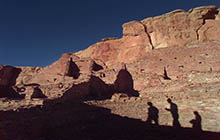When Joe Mozingo came back from the Salt Lake City in September 2012, he had a lot of TV to watch. Mozingo, a reporter for the Los Angeles Times, had been on assignment investigating an FBI sting when when a source gave him a cache of discs that contained more than 100 hours of undercover footage.
Taken together, they told the story of Ted Gardiner, an FBI informant who’d killed himself after helping expose an underground trade in illicit artifacts stolen from Anasazi land in Utah. The footage showed clandestine meetings between Gardiner and would-be criminals that eventually became the foundation of a six-chapter multimedia investigation loaded with original footage and actualities.

Gardiner. (Screenshot from Los Angeles Times via Gardiner family)
But before it became a story, it was just a box filled with discs. Mozingo began reviewing the footage but quickly became frustrated. With so much information, it was difficult to know where to start.
“I couldn’t figure out how, and I kind of moved on to other things,” he said.
Months passed. The chance of losing a potentially great story began to eat at Mozingo. He didn’t have a breakthrough until December, when he was having lunch with an editor at the L.A. Times. After their conversation, he charted a new course for the story by focusing on the people who were most affected by the investigation.
It was a revelation. When he picked the story up again in February, Mozingo started organizing the story around the Redds, a family that had been torn apart by the sting. James Redd, a doctor, had ultimately killed himself after being charged with a felony for buying Anasazi artifacts. His wife and daughter had been fined and put on probation.
“These were the people who paid the price,” Mozingo said.

Funeral for James Redd (Trent Nelson, the Salt Lake Tribune)
Mozingo began a preliminary sketch of the narrative arc on a big legal pad, drawing connections between scenes and themes until the web of the story looked like a circuit board, he said. But before he had a complete picture, he had to watch all the tapes.
It was frustrating task. For one thing, each disc contained footage of varying length and value; some had juicy meetings between Gardiner and his subjects, some just contained hours of useless audio — shovels scraping in the dirt, small talk, that kind of thing. Also, Mozingo found it difficult to keep his eyes and ears glued to hours and hours of undercover footage as the day wore on.
To cope with the tedium, Mozingo took all the discs home and built himself a makeshift desk that doubled as a treadmill. He hammered four eight-by-six pine boards together, draped them over his treadmill and set his laptop computer on top of it.
Then he began watching.
Most of September 2013 was a complete binge-watching session. He tried to walk eight to 10 miles a day while taking notes. After watching about a quarter of the footage, he realized that he needed a transcript to refer back to. So he popped the discs in again, re-watched everything and made a 61,000-word transcript that went on for 55 pages of 11-point font. He put that in one of eight 3-ring binders that contained all the information for the stories and began writing his story in earnest.
It went quickly. In November 2013, he submitted a 20,000-word first draft that he knew would never make it into the paper. Then he worked with editors to find places to cut. Background about the Anasazi people? Trimmed. B-matter about the history of a Utah town? Downsized. Ultimately, the piece was pared down to a little more than 5,000 words.
After the draft was done, the LA Times graphics desk began formatting the video and audio for the story into a multimedia piece. And last week, two years after Mozingo came back from his first visit to Utah, the story was finally published.
Mozingo’s advice for journalists facing similar daunting projects? Don’t give up. Figure out everything you can about the story as early as you can — and don’t let yourself be overwhelmed by a tide of information.
“I’ve seen other writers try to do these things and get lost,” Mozingo said. “And that’s the easiest thing to do.”
Another writing tip from the story: keep your eye out for pivot points while you’re reporting. The revelation that Gardiner is an FBI informant dramatically changes the direction of the story and propels it along, as does subsequent surprises — the FBI raid of the Redds and James Redd’s suicide.
“As far as narrative structure, you need to find your pivot points where the narrative takes a turn — the critical moments that drive the narrative in other directions.”






